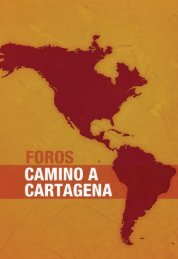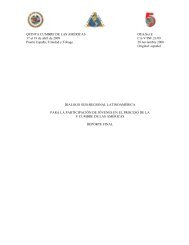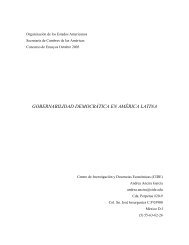The Road to Hemispheric Cooperation: Beyond the Cartagena
The Road to Hemispheric Cooperation: Beyond the Cartagena
The Road to Hemispheric Cooperation: Beyond the Cartagena
Create successful ePaper yourself
Turn your PDF publications into a flip-book with our unique Google optimized e-Paper software.
agencies, including Spain’s Ibero-American Carbon Initiative,<br />
and a number of investment funds resulting in new energy<br />
generation facilities that use renewable resources, forestry<br />
related activities, and an expanded biofuel production.<br />
While <strong>the</strong> CAF, on its own, might not have <strong>the</strong> resources<br />
and personnel <strong>to</strong> administer a CDM for <strong>the</strong> entire Western<br />
Hemisphere, this task could be divided among different<br />
sub-regional entities with a proven track record of reliability.<br />
Whereas <strong>the</strong> CAF might be assigned <strong>the</strong> Andean region<br />
of South America (including Chile), similar roles could be<br />
entrusted <strong>to</strong> <strong>the</strong> Central American Bank for Economic Integration,<br />
<strong>the</strong> North American Development Bank, and <strong>the</strong><br />
Caribbean Development Bank, respectively, in those three<br />
sub-regions. Fur<strong>the</strong>rmore, a CDM for <strong>the</strong> Mercosur countries<br />
could be assigned <strong>to</strong> <strong>the</strong> Financial Fund for <strong>the</strong> Development<br />
of <strong>the</strong> Rio de la Plata Basin (FONPLATA).<br />
A CDM limited <strong>to</strong> <strong>the</strong> Western Hemisphere might also neutralize<br />
Brazil’s refusal—premised on his<strong>to</strong>rical sovereignty<br />
concerns about “internationalizing” <strong>the</strong> Amazon—<strong>to</strong> permit<br />
use of <strong>the</strong> current multilateral CDM <strong>to</strong> fund any type of forest<br />
conservation or reforestation projects in <strong>the</strong> Amazon. This is<br />
a serious bottleneck because Brazil is home <strong>to</strong> 65 percent<br />
of <strong>the</strong> Amazonian rain forest. 21 Brazil might be less resistant<br />
<strong>to</strong> an effort <strong>to</strong> utilize projects in <strong>the</strong> Amazon <strong>to</strong> gain carbon<br />
offsets under a CDM limited <strong>to</strong> <strong>the</strong> Western Hemisphere.<br />
Evidence of this can be garnered from <strong>the</strong> Memorandum of<br />
Understanding (MOU) on <strong>Cooperation</strong> Regarding Climate<br />
Change that Brazil and <strong>the</strong> United States signed in March<br />
2010. Under this MOU, both countries have agreed <strong>to</strong> cooperate<br />
in reducing emissions from deforestation and forest<br />
degradation pursuant <strong>to</strong> <strong>the</strong> U.N.’s Reducing Emissions<br />
from Deforestation and Forest Degradation (REDD)-plus<br />
program. 22 <strong>The</strong> goals sought through REDD-plus are compatible<br />
with ECPA’s sixth pillar of Promoting Sustainable<br />
Forestry and Land Use, described above, which seeks <strong>to</strong><br />
reduce emissions from deforestation and forest degradation,<br />
as well as <strong>to</strong> enhance carbon sequestration in <strong>the</strong> land<br />
use sec<strong>to</strong>r.<br />
A hemispheric CDM could free Caribbean island states<br />
from <strong>the</strong>ir heavy dependence on imported crude oil and<br />
refined petroleum for transport and electricity generation<br />
which has made <strong>the</strong>m among <strong>the</strong> most heavily indebted nations<br />
in <strong>the</strong> world on a debt-<strong>to</strong>-GDP basis. 23 Although <strong>the</strong>re<br />
is a wide mix of renewable energy resources such as hydro<br />
(including exploiting strong ocean currents), solar, wind and<br />
geo<strong>the</strong>rmal available on different islands, exploiting <strong>the</strong>m<br />
<strong>to</strong> generate energy is complicated by miniscule markets.<br />
This makes it difficult for private inves<strong>to</strong>rs <strong>to</strong> recoup a return<br />
on <strong>the</strong>ir initial investment within a reasonable time frame.<br />
Accordingly, without <strong>the</strong> existence of some type of external<br />
incentive, <strong>the</strong> money <strong>to</strong> develop such projects is unlikely<br />
<strong>to</strong> appear. That scenario changes in <strong>the</strong> context of a<br />
hemispheric cap-and-trade program where, for example, a<br />
Canadian or U.S. utility company seeking a carbon offset<br />
might be willing <strong>to</strong> invest in an electric generation facility in<br />
Dominica that makes use of <strong>the</strong> country’s extensive geo<strong>the</strong>rmal<br />
potential.<br />
<strong>The</strong> Challenges<br />
Promoting reliable access <strong>to</strong> energy resources, particularly<br />
fossil fuels, throughout <strong>the</strong> Western Hemisphere is<br />
hampered by <strong>the</strong> fact that countries such as Mexico constitutionally<br />
prohibit foreign ownership rights in <strong>the</strong> hydrocarbons<br />
sec<strong>to</strong>r. In addition, <strong>the</strong> region has been plagued<br />
by a resurgence of resource nationalism in recent years<br />
that has curtailed foreign investment and technology<br />
transfer and has reduced output. This inability <strong>to</strong> establish<br />
a consensus on <strong>the</strong> role played by private inves<strong>to</strong>rs in<br />
<strong>the</strong> energy sec<strong>to</strong>r was even evident at <strong>the</strong> Sixth Summit<br />
of <strong>the</strong> Americas in <strong>Cartagena</strong>. <strong>The</strong>re, Argentine President<br />
Cristina Fernández de Kirchner rushed home early and<br />
promptly nationalized 51 percent of Repsol-YPF, thus reducing<br />
Repsol’s ownership stake from approximately 57<br />
percent <strong>to</strong> just over 6 percent. 24 This nationalization damages<br />
any initiative promoting private sec<strong>to</strong>r participation in<br />
<strong>the</strong> integration of regional energy markets at <strong>the</strong> regional<br />
or hemispheric level.<br />
Complications also exist with respect <strong>to</strong> connecting <strong>the</strong><br />
different electrical grid systems. Existing cross-border<br />
infrastructure for gas and electricity in South America is<br />
<strong>the</strong> result of an ad hoc approach <strong>to</strong> energy trade between<br />
neighboring countries and not a result of policies and rules<br />
designed <strong>to</strong> facilitate long-term cooperation and network<br />
development. 25 That may explain why Colombia—considered<br />
<strong>the</strong> electricity powerhouse for <strong>the</strong> Andean region—<br />
exported approximately 1000 gigawatt hours of electricity<br />
<strong>to</strong> Ecuador and about 300 gigawatt hours <strong>to</strong> Venezuela in<br />
2009, out of a <strong>to</strong>tal production of 57,618 gigawatt hours.<br />
<strong>The</strong> <strong>Road</strong> <strong>to</strong> <strong>Hemispheric</strong> <strong>Cooperation</strong>: <strong>Beyond</strong> <strong>the</strong> <strong>Cartagena</strong> Summit of <strong>the</strong> Americas<br />
<strong>The</strong> Brookings Institution ❘ Latin America Initiative<br />
51








